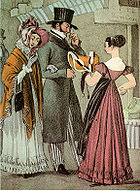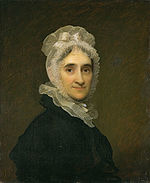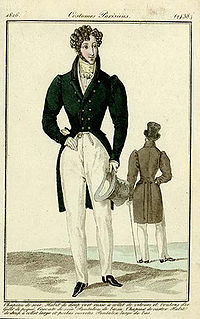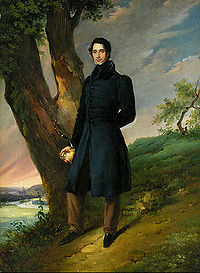
1820s in fashion
Encyclopedia

Empire silhouette
An Empire silhouette is created by a woman wearing a high-waisted dress, gathered near or just under the bust with a long, loose skirt, which skims the body. The outline is especially flattering to pear shapes wishing to disguise the stomach area or emphasise the bust. The shape of the dress also...
) and re-adopted elements that had been characteristic of most of the 18th century (and were to be characteristic of the remainder of the 19th century), such as full skirts and clearly visible corset
Corset
A corset is a garment worn to hold and shape the torso into a desired shape for aesthetic or medical purposes...
ing of the natural waist.
The silhouette of men's fashion changed in similar ways: by the mid-1820s coats
Coat (clothing)
A coat is a long garment worn by both men and women, for warmth or fashion. Coats typically have long sleeves and are open down the front, closing by means of buttons, zippers, hook-and-loop fasteners, toggles, a belt, or a combination of some of these...
featured broad shoulders with puffed sleeves, a narrow waist, and full skirts. Trousers
Trousers
Trousers are an item of clothing worn on the lower part of the body from the waist to the ankles, covering both legs separately...
were worn for smart day wear, while breeches
Breeches
Breeches are an item of clothing covering the body from the waist down, with separate coverings for each leg, usually stopping just below the knee, though in some cases reaching to the ankles...
continued in use at court and in the country.
Overview


Trim (sewing)
Trim or trimming in clothing and home decorating is applied ornament, such as gimp, passementerie, ribbon, ruffles, or, as a verb, to apply such ornament....
(sometimes large and ornate) applied horizontally around the dress near the hem. Sleeves also began increasing in size, foreshadowing the styles of the 1830s. However, there was still no radical break with the Empire/Regency aesthetic.
During the second half of the 1820s, this neoclassical aesthetic was decisively repudiated, preparing the way for the main fashion features of the next ten to fifteen years (large sleeves, somewhat strict corseting of the natural waist, full skirts, elaborate large-circumference hats, and visual emphasis on wide sloping shoulders). Rich colors such as chrome yellow
Chrome yellow
Chrome Yellow is a natural yellow pigment made of lead chromate . It was first extracted from the mineral crocoite by the French chemist Louis Vauquelin in 1809...
and Turkey red
Rubiá
aRubiá is a municipality in the Spanish province of Ourense. It has a population of 1734 and an area of 101 km²....
became popular, and fabrics with large bold checkerboard or plaid patterns became fashionable, (another contrast with the previous fashion period, which had favored small delicate pastel prints). A bustle
Bustle
A bustle is a type of framework used to expand the fullness or support the drapery of the back of a woman's dress, occurring predominantly in the mid-to-late 19th century. Bustles were worn under the skirt in the back, just below the waist, to keep the skirt from dragging. Heavy fabric tended to...
was sometimes also worn. Belts accentuated the new defined waist.
Dresses were often worn with a round ruffled linen collar similar to a soft Elizabethan ruff
Ruff (clothing)
A ruff is an item of clothing worn in Western Europe from the mid-sixteenth century to the mid-seventeenth century.The ruff, which was worn by men, women and children, evolved from the small fabric ruffle at the drawstring neck of the shirt or chemise...
.
Hairstyles and headgear
Early in the decade, hair was parted in the center front and styled into tight curls over the temples. As the decade progressed, these curls became more elaborate and expansive. The bun on the back became a looped knot worn high on top of the head. Wide-brimmed hats and hat-like bonnets with masses of feathers and ribbon trims were worn by mid-decade.Conservative married or older women wore indoor caps of fine linen
Linen
Linen is a textile made from the fibers of the flax plant, Linum usitatissimum. Linen is labor-intensive to manufacture, but when it is made into garments, it is valued for its exceptional coolness and freshness in hot weather....
descended from the earlier mob cap
Mob cap
A mob cap or mob-cap is a round, gathered or pleated cloth bonnet consisting of a caul to cover the hair, a frilled or ruffled brim, and a ribbon band, worn by married women in the Georgian period, when it was called a "bonnet"...
; these had a pleated or gathered caul on the back to cover the hair, and a narrow brim at the front that widened to cover the ears and often tied under the chin. These caps were worn under bonnets for street-wear.
Outerwear
ShawlShawl
A shawl is a simple item of clothing, loosely worn over the shoulders, upper body and arms, and sometimes also over the head. It is usually a rectangular or square piece of cloth, that is often folded to make a triangle but can also be triangular in shape...
s remained popular. Cloak
Cloak
A cloak is a type of loose garment that is worn over indoor clothing and serves the same purpose as an overcoat; it protects the wearer from the cold, rain or wind for example, or it may form part of a fashionable outfit or uniform. Cloaks are as old as human history; there has nearly always been...
s and full-length coats
Coat (clothing)
A coat is a long garment worn by both men and women, for warmth or fashion. Coats typically have long sleeves and are open down the front, closing by means of buttons, zippers, hook-and-loop fasteners, toggles, a belt, or a combination of some of these...
were worn in cold or wet weather
Style gallery 1820–25
- Mademoiselle Gonin wears a dark dress with small puffed sleeves, with a ruffled collar and a blue plaid ribbon at the neck. Her hair is styled into small curls at her temples.
- Collette Versavel's blue dress of 1822 is slightly cone-shaped, and is trimmed with frills around the hem. She carries a deep red shawlShawlA shawl is a simple item of clothing, loosely worn over the shoulders, upper body and arms, and sometimes also over the head. It is usually a rectangular or square piece of cloth, that is often folded to make a triangle but can also be triangular in shape...
with a paisleyPaisleyPaisley is the largest town in the historic county of Renfrewshire in the west central Lowlands of Scotland and serves as the administrative centre for the Renfrewshire council area...
patterned border. - Antonietta Vitali Sola wears an arrangement of tight, vertical curls at her temples. Her sheer chemise or chemisette has a double ruffled collar, 1823.
- Evening gown of 1823 has a sheer overskirt.
- Fashion plate of a "carriage" or travelling dress of 1824 has fur trim and a matching muff. Note lower waist, fuller sleeves, and wider skirt.
- Marchesa Marianna Florenzi wears a fur-trimmed dress with a belt over a white ruffled undergown and carries a feather-trimmed bonnet, 1824
- The Duchess de Berry's fashion-forward gown of 1825 shows the wide waistband that was gradually lowering waistlines. Her fitted bodice and prominent headdress would be important styles for the next several years.
Style gallery 1826–29
- Madame Marie Marcotte wears a brown gown with a wide buckled belt, full sleeves, and a sheer collar with shell buttonButtonIn modern clothing and fashion design, a button is a small fastener, most commonly made of plastic, but also frequently of seashell, which secures two pieces of fabric together. In archaeology, a button can be a significant artifact. In the applied arts and in craft, a button can be an example of...
s. Her hair is worn in elaborate curls on the sides and on top. 1826. - Viennese fashion plate of 1826. Stripes run in different directions on the skirt, hem and sleeves, and the hat is lined with plaid fabric and trimmed with a matching ribbon.
- Comtesse de MacMahon wears a satin dress with a conical skirt trimmed with horizontal frills at the hem. Matching frills accent the new wide-puffed sleeves. She wears a large hat decorated with ostrich plumes, latter half of the 1820s.
- Auguste Strobl wears a sheer overdress with full sleeves in the new fashion over a white gown with short puffed undersleeves. A wide ribbon sash is fastened with a gold buckle. German, 1827.
- Sarah Stanton Blake wears a frilled indoor cap trimmed with sheer ribbon and a high-necked chemise or chemisette under her black dress and scarlet shawl. Massachusetts, c. 1827.
- Dress of silk and cotton gauze, dyed chrome yellowChrome yellowChrome Yellow is a natural yellow pigment made of lead chromate . It was first extracted from the mineral crocoite by the French chemist Louis Vauquelin in 1809...
and block printed with a chinoiserieChinoiserieChinoiserie, a French term, signifying "Chinese-esque", and pronounced ) refers to a recurring theme in European artistic styles since the seventeenth century, which reflect Chinese artistic influences...
pattern, Europe, c. 1827. Los Angeles County Museum of ArtLos Angeles County Museum of ArtThe Los Angeles County Museum of Art is an art museum in Los Angeles, California. It is located on Wilshire Boulevard along Museum Row in the Miracle Mile vicinity of Los Angeles, adjacent to the George C. Page Museum and La Brea Tar Pits....
, M.2007.211.937. - Evening gown of 1828 shows the beginnings of the dropped shoulder and wide sleeve puff that would flower in the 1830s. Hair is worn in elaborate side curls, and the knotted bun is higher on the crown of the head. German.
- Regina Daxenberger wears sheer blue oversleeves with short puffed undersleeves. Her fitted bodice has pairs of waist darts, 1829.
- Fashion plate shows "Newest Fashions for May 1829: Morning and Evening Dresses"
Men's fashions


Overview
By the mid-1820s, men's fashion plates show a shapely ideal silhouette with broad shoulders emphasized with puffs at the sleevehead, a narrow waist, and very curvy hips.A corset
Corset
A corset is a garment worn to hold and shape the torso into a desired shape for aesthetic or medical purposes...
was required to achieve the tiny waistline shown in fashion plates. Already de rigueur in the wardrobes of military officers, men of all middle and upper classes began wearing them, out of the necessity to fit in with the fashionable gentry. Usually referred to as "girdles", "belts" or "vests" (as "corsets" and "stays" were considered feminine terms) they were used to cinch the waist to sometimes tiny proportions, although sometimes they were simply whalebone-stiffened waistcoats with lacing in the back. Many contemporary cartoonists of the time poked fun at the repressed nature of the tightlaced gentlemen, although the style grew in popularity nonetheless. This was the case especially amidst middle-class men, who often used their wardrobe to promote themselves, at least in mind, to a higher class — hence the dandy
Dandy
A dandy is a man who places particular importance upon physical appearance, refined language, and leisurely hobbies, pursued with the appearance of nonchalance in a cult of Self...
was born.
Shirts and cravats
ShirtShirt
A shirt is a cloth garment for the upper body. Originally an undergarment worn exclusively by men, it has become, in American English, a catch-all term for almost any garment other than outerwear such as sweaters, coats, jackets, or undergarments such as bras, vests or base layers...
s of linen or cotton featured tall standing collars
Collar (clothing)
In clothing, a collar is the part of a shirt, dress, coat or blouse that fastens around or frames the neck. Among clothing construction professionals, a collar is differentiated from other necklines such as revers and lapels, by being made from a separate piece of fabric, rather than a folded or...
and were worn with wide cravats
Necktie
A necktie is a long piece of cloth worn for decorative purposes around the neck or shoulders, resting under the shirt collar and knotted at the throat. Variants include the ascot tie, bow tie, bolo tie, and the clip-on tie. The modern necktie, ascot, and bow tie are descended from the cravat. Neck...
tied in a soft bow.
Coats and waistcoats
Coats and waistcoatWaistcoat
A waistcoat or vest is a sleeveless upper-body garment worn over a dress shirt and necktie and below a coat as a part of most men's formal wear, and as the third piece of the three-piece male business suit.-Characteristics and use:...
s had high shawl-like collars to frame the face and were cut straight across the waist. Waistcoats were buttoned high on the chest. Cutaway coats were worn as in the previous period for formal daywear, but the skirts might almost meet at the front waist.
Frock coat
Frock coat
A frock coat is a man's coat characterised by knee-length skirts all around the base, popular during the Victorian and Edwardian periods. The double-breasted style is sometimes called a Prince Albert . The frock coat is a fitted, long-sleeved coat with a centre vent at the back, and some features...
s had the same nipped-in waist and full skirts. Very fashionable sleeves were gathered or pleated into a slightly puffed "leg of mutton" shape. Coats could be made of wool
Wool
Wool is the textile fiber obtained from sheep and certain other animals, including cashmere from goats, mohair from goats, qiviut from muskoxen, vicuña, alpaca, camel from animals in the camel family, and angora from rabbits....
or velvet
Velvet
Velvet is a type of woven tufted fabric in which the cut threads are evenly distributed,with a short dense pile, giving it a distinctive feel.The word 'velvety' is used as an adjective to mean -"smooth like velvet".-Composition:...
, and jewel colors like bottle green and midnight blue were high style. Double-breasted
Double-breasted
In clothing, the term double-breasted refers to a coat or jacket with wide, overlapping front flaps and two parallel columns of buttons or snaps; by contrast, a single-breasted coat has a narrow overlap and only one column of buttons. In most modern double-breasted coats, one column of buttons is...
coats were very much in fashion throughout the decade.
Trousers and breeches
Full-length light-colored trousers were worn for day; these were cut full through the hips and thighs, tapering to the ankles. They were held smoothly in place by straps fastened under the square-toed shoes. Dark trousers were worn for evening wear, and breeches were worn for formal functions at the BritishUnited Kingdom
The United Kingdom of Great Britain and Northern IrelandIn the United Kingdom and Dependencies, other languages have been officially recognised as legitimate autochthonous languages under the European Charter for Regional or Minority Languages...
court (as they would be throughout the century). Breeches were also worn for horseback riding and other country pursuits, especially in Britain, with tall fitted boots.
Hats and hairstyles
The crowns of tall hatHat
A hat is a head covering. It can be worn for protection against the elements, for ceremonial or religious reasons, for safety, or as a fashion accessory. In the past, hats were an indicator of social status...
s also became curvy in keeping with the new style, and began to flare from the headband to the top. Curled hair
Hair
Hair is a filamentous biomaterial, that grows from follicles found in the dermis. Found exclusively in mammals, hair is one of the defining characteristics of the mammalian class....
and sideburns were fashionable.
Style gallery
- President James Monroe wears a high shirt collar and white cravat tied in a wide bow. His jacket collar and lapels form a continuous curve very like a shawl collar. 1820–22.
- Country clothes in the city: In this caricature by Richard DightonRichard DightonRichard Dighton , was an English artist in the Regency period, best known for his many satirical profile portraits of contemporary London celebrities and characters....
, a stout man wears country clothes (breeches and riding boots) at the Royal Exchange in London. Hats of 1823 are not yet curvy, and the straight-bottomed waistcoat shows slightly below the coat in front. - French fashion plate shows an evening cape or manteau with a fur collar and shoulder cape, worn over dark formal breeches and double-breasted coat, 1823.
- Conte Ninni wears a black coat with a tall collar and a slight puff at the sleeve head over a tall-collared white shirt and white cravat, 1825.
- Francisco de Goya wears a gray coat over a satin single-breasted waistcoat and a tall-collared shirt that reaches to his ears, with a white cravat. SpanishSpainSpain , officially the Kingdom of Spain languages]] under the European Charter for Regional or Minority Languages. In each of these, Spain's official name is as follows:;;;;;;), is a country and member state of the European Union located in southwestern Europe on the Iberian Peninsula...
, 1826. - Baron Schwiter wears a dark cutaway coat, waistcoat, and narrow fitted pantaloons or trousers. His flat shoes have square toes and bows on the instep, and are worn with white stockings, 1827.
- Goethe wears a coat with a slight puff at the sleeve head, a satin lining turned back to form lapels, and a high contrasting collar over a patterned waistcoat. His white cravat is fastened with a gold pin. German, 1828.
- In his self-portrait, Ferdinand Georg WaldmüllerFerdinand Georg WaldmüllerFerdinand Georg Waldmüller was an Austrian painter and writer.He briefly attended the Academy of Fine Arts Vienna, but later had to finance his life by painting portraits. In 1811 he worked as a teacher of arts for the children of Count Gyulay in Croatia...
wears a striped cravat and striped waistcoat, both in dull gold and blue, 1828.

